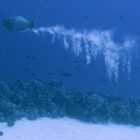Why does the Parrotfish surround itself with mucus while sleeping?

With its kaleidoscopic colors and distinctive beaks, the parrotfish stands out among the denizens of the coral ecosystem. Yet, one peculiar behavior of the parrotfish has long intrigued marine biologists and curious observers alike: the creation of mucus beds during their nightly slumber.
The Enigma of Mucus Beds
As the sun sets and the reef transforms into a nocturnal landscape, the parrotfish embarks on a unique sleeping ritual. Unlike their diurnal activities, where they graze on algae and coral, the nighttime brings a different set of challenges and opportunities for these tropical reef-dwellers. It is during this transition from day to night that the parrotfish unveils its enigmatic practice of enveloping itself in a translucent cocoon of mucus.
This nocturnal behavior stands in stark contrast to the vibrant, bustling activity witnessed during daylight hours. The process of the parrotfish enveloping itself in a cocoon of mucus is a captivating spectacle that raises the question: what prompts this seemingly elaborate sleeping ritual?
Parrotfish Sleeping Ritual
The first step in the parrotfish sleeping ritual involves the selection of an appropriate resting site. Parrotfish are meticulous in their choice, often opting for sheltered crevices or sandy patches on the ocean floor. This careful selection reflects their awareness of the importance of safety during the vulnerable period of sleep.
Once the parrotfish has found its chosen spot, it begins to release a sticky, viscous substance from specialized mucous glands located on its skin. This mucus, initially appearing as a thin film, gradually transforms into a more substantial, protective cocoon. The parrotfish deftly maneuvers its body, ensuring that the mucus covers every inch, creating a translucent shield against the nocturnal perils of the reef.
As the mucus cocoon solidifies, the parrotfish assumes a distinctive posture, often curling its body or tucking its head into the protective embrace of its mucous shelter. This posture, combined with the now fully formed mucus bed, marks the initiation of the parrotfish’s slumber.
Sanctuary of Mucus
The mucus bed not only acts as a physical barrier but also plays a vital role in the parrotfish’s ability to navigate the darkness of the night. The transparent nature of the mucus allows the parrotfish to maintain a level of awareness of its surroundings, enabling it to react swiftly to potential threats. This adaptive strategy showcases the parrotfish’s ability to balance the need for protection with the necessity of remaining vigilant in its sleep.
Often, these fish gather in groups to create a collective sanctuary of mucus beds. This communal behavior may provide additional layers of protection, as the combined mucous presence could serve as a deterrent to potential predators in the vicinity.
As the night progresses, the parrotfish remains nestled in its mucus bed, shielded from the unseen dangers of the nocturnal reef. With the first light of dawn, the parrotfish awakens, gracefully emerging from its mucous cocoon to resume its diurnal activities.
Defense Mechanism Against Predators
The evolution of the parrotfish’s mucus beds as a defense mechanism against predators reveals a fascinating adaptation to the challenges of the underwater world. In the cover of night, when the coral reef undergoes a transformative shift from vibrant daylight to an inky darkness, parrotfish navigate the perils of the nocturnal seascape using a strategy that involves more than just finding a cozy spot to rest.
The mucus bed, essentially a translucent shield, serves as the first line of defense against predators that prowl the reefs after sunset. As the parrotfish secretes a specialized mucous substance, it envelops itself in a protective cocoon, rendering it less visible to potential threats. This visual concealment is crucial in an environment where many predators rely on keen eyesight to locate their prey.
The sticky consistency of the mucus adds an extra layer of complexity to the parrotfish’s defense strategy. It poses a challenge to predators attempting to grasp the fish with their mouths. Predatory fish, such as moray eels or larger nocturnal species, may find it difficult to secure a firm grip on the slippery parrotfish, reducing the likelihood of a successful attack. The mucus acts as a slippery barrier, thwarting potential predators and providing the parrotfish with precious moments to escape or take evasive maneuvers.
Beyond its physical properties, the mucus bed also plays a psychological role in deterring predators. The unknown texture and stickiness of the mucus may startle or discourage predators, making them think twice before attempting to make a meal of the parrotfish. This element of surprise can be a powerful tool in the parrotfish’s arsenal, contributing to its overall survival strategy.
Chemical Camouflage and Parasite Prevention
The mucus produced by parrotfish is not merely a physical shield; it is a sophisticated blend of biochemical compounds that serves multiple purposes. One of the primary functions of this mucous shield is to act as a form of chemical camouflage. In the underwater world, where predators rely heavily on olfactory cues, the parrotfish has evolved an ingenious strategy to mask its scent.
The chemical composition of the mucus is thought to contain compounds that either mimic the surrounding environment or confuse the sensory perceptions of potential predators. By doing so, the parrotfish becomes a cryptic entity in the darkness of the reef, making it challenging for nocturnal hunters to detect its presence.
Beyond its role in avoiding detection, the mucus serves as a barrier against parasites that might seek to exploit the parrotfish as a host. Coral reefs, with their rich biodiversity, are also hotspots for various marine parasites. The mucous layer, with its sticky consistency, creates an environment less favorable for parasites to attach and establish themselves on the fish’s skin.
Thermal Regulation and Hydration
The underwater world of coral reefs is a dynamic environment with temperature fluctuations that pose challenges to its inhabitants. For the parrotfish, mastering thermal regulation is crucial, and the creation of mucus beds during sleep plays a pivotal role in maintaining a stable microenvironment.
As the sun sets and the underwater landscape transitions into darkness, the parrotfish seeks a suitable resting place on the reef. Once settled, the intricate process of mucus production begins. This thin, protective layer of mucus serves as a thermal buffer against the temperature variations that occur during the night.
In the tropical waters where parrotfish thrive, nighttime temperatures can dip, posing potential risks to cold-blooded organisms like fish. The mucus bed acts as a barrier, insulating the parrotfish from the cooler surrounding waters. By creating a microenvironment that retains heat, the mucus helps prevent sudden drops in the fish’s body temperature, ensuring that it remains within the optimal range for physiological functions.
Furthermore, the mucus layer aids in the prevention of dehydration, an ever-present concern in the saltwater environment. The permeable nature of the mucus allows the fish to retain moisture, reducing water loss during the night when the parrotfish is less active and not engaged in feeding activities. This adaptation is particularly vital given the continuous osmotic challenges posed by the surrounding seawater.
Parrotfish sleep in a mosquito net made of mucus










